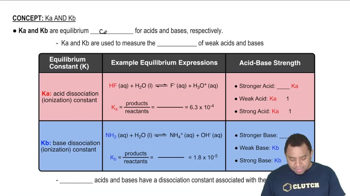Here are the essential concepts you must grasp in order to answer the question correctly.
Henderson–Hasselbalch Equation
The Henderson–Hasselbalch equation is a mathematical formula used to relate the pH of a solution to the concentration of an acid and its conjugate base. It is expressed as pH = pKa + log([A-]/[HA]), where pKa is the negative logarithm of the acid dissociation constant (Ka). This equation is particularly useful in biochemistry for understanding buffer systems in biological fluids.
Recommended video:
Henderson-Hasselbalch Equation
Acid Dissociation Constant (Ka)
The acid dissociation constant (Ka) quantifies the strength of an acid in solution, indicating how well it donates protons (H+) to water. A lower Ka value signifies a weaker acid, while a higher value indicates a stronger acid. For carbonic acid, with a Ka of 7.9 x 10^-7 at body temperature, this value helps determine the equilibrium concentrations of HCO3- and H2CO3 in blood at a specific pH.
Recommended video:
Characteristics of Ka and Kb
Buffer Systems in Blood
Buffer systems in blood, primarily involving bicarbonate (HCO3-) and carbonic acid (H2CO3), help maintain a stable pH in the physiological range. These buffers resist changes in pH by neutralizing excess acids or bases. The Henderson–Hasselbalch equation is essential for calculating the ratio of these components, which is crucial for understanding acid-base balance in the body, especially at a pH of 7.40.
Recommended video:
 Verified step by step guidance
Verified step by step guidance

